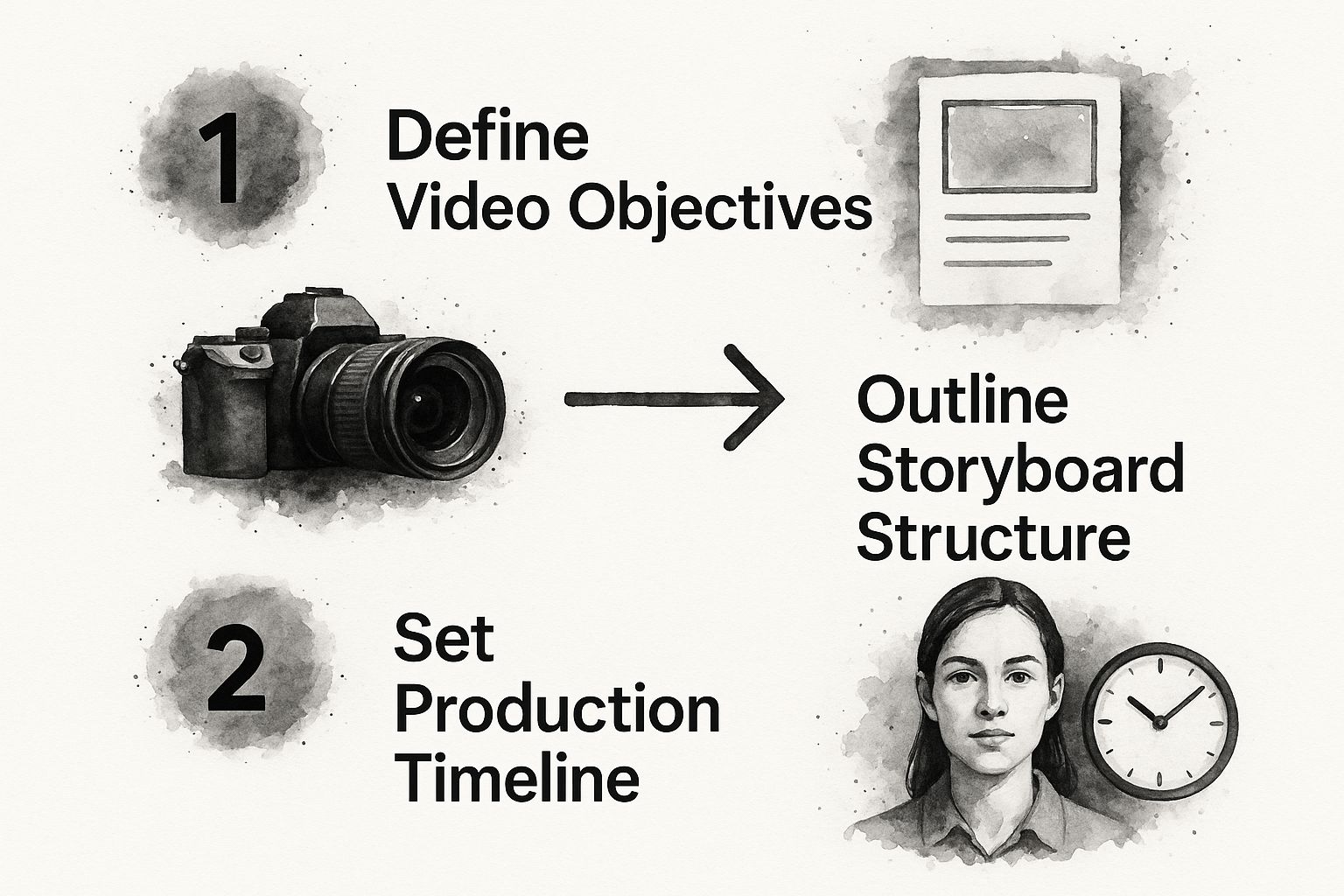A product demonstration video isn't just a marketing asset; it's a short, focused film designed to show potential customers exactly how your product works. It goes far beyond static photos by showcasing features in action, answering the questions people are already asking, and really hammering home the real-world value.
When done right, a great demo builds serious buyer confidence and can dramatically speed up purchasing decisions.
Why a Product Demonstration Video Is Your Best Salesperson

Let's be honest, text and images can only do so much. A product demo video is what bridges that crucial gap between seeing a product and truly understanding its impact. It’s your chance to personally guide a potential customer through the user experience, building the trust they need to feel good about making a purchase.
The numbers don't lie. A staggering 98% of people have watched an explainer or demo video to learn more about a product or service. This isn't just a fleeting trend; it’s a fundamental shift in how people shop, which is why 73% of video marketers now prioritize creating demos over any other type of video.
Tangible Business Results
Showing your product in motion delivers real business value that goes way beyond simple view counts. A great demo video preemptively answers customer questions, which smooths out the sales process and can even cut down on the number of support tickets your team has to handle later. This proactive approach empowers customers, making them more confident from the get-go.
To help you see the bigger picture, here's a quick rundown of the major advantages.
Key Benefits of Product Demonstration Videos
This table offers a quick summary of the primary advantages a well-made product demo video brings to a business.
| Benefit | Business Impact |
|---|---|
| Increased Conversions | Turns passive browsers into active buyers by clearly showing value. |
| Reduced Support Tickets | Answers common questions upfront, leading to fewer post-purchase issues. |
| Builds Trust & Confidence | A transparent look at the product eliminates doubt and builds credibility. |
| Highlights Key Features | Showcases unique selling points in a dynamic, memorable way. |
| Improves SEO & Traffic | Videos on product and landing pages can boost search rankings. |
Ultimately, these benefits work together to create a more informed and confident customer base.
A strong video sales demonstration helps customers envision themselves using your product to solve their pain points or empower them to reach a goal. It paints a picture of their dream solution, helping them visualize how the product will impact their life.
By clearly illustrating value, you're not just showing off features; you're building a compelling case for how your product improves a customer’s life or work.
If you really want to understand how videos can become your most effective salesperson, you should check out this fantastic guide to high-converting landing page videos. And for a deeper look into the mechanics of it all, you can also read our own deep dive on how video helps sell stuff to see the impact for yourself.
Mapping Out Your High-Impact Demo Video
A great product demo video never happens by accident. It's the result of a smart, focused plan. Before you even think about hitting record, you have to lay the strategic groundwork. The absolute first step? Define one clear, singular goal for your video.
What are you trying to accomplish? Are you looking to build top-of-funnel awareness and just introduce your product to the world? Or is your goal to nudge a warm lead—someone who already knows you—closer to making a purchase? Trying to do both at once is a recipe for a diluted message and a confused viewer. A video aimed at boosting trial sign-ups will look and feel completely different from one designed to be shared widely on social media.
Pinpoint the Problem and Hero Features
Once your objective is locked in, it's time to shift your focus to the viewer. Who, exactly, is this video for? And more importantly, what's the single biggest headache they're dealing with that your product can solve?
A killer demo doesn't just run through a laundry list of features. It hones in on the one or two "hero features" that directly tackle that main pain point.
This is how you create that "aha!" moment everyone talks about. For example, if your audience is drowning in disorganized project workflows, your video shouldn't waste a second on billing features. You'd want to laser-focus on your collaborative dashboard and task-assignment tools—the stuff that brings immediate order to their chaos.
A truly effective demo video doesn't just show what a product does. It tells a compelling story where the customer is the protagonist, and your product is the tool that helps them win.
When you frame it this way, your demonstration feels less like a sales pitch and more like a genuinely helpful guide.
The infographic below breaks down this core planning process, showing how you move from high-level goals to a concrete production schedule.

This visual flow makes it clear: a solid strategy has to come before any of the creative or technical work. It ensures every decision you make supports the main goal.
Set a Realistic Budget and Timeline
Finally, you have to align your grand vision with practical reality. Setting a realistic budget and timeline right from the start is the best way to prevent scope creep and keep the project from derailing. Your budget will dictate everything, from the camera you use to whether you can afford to hire professional voice-over talent.
- Scrappy Start-up: A simple, well-lit screen recording you create in-house might be all you need for a targeted walkthrough.
- Established Brand: For a major product launch, you might need a higher-budget production with polished graphics and animation to make a splash.
Just remember, a well-planned, focused video on a shoestring budget will always outperform an expensive, rambling one. Planning isn’t just boring paperwork; it’s the most important thing you'll do to create a product demo that actually gets results.
Crafting a Script That Connects and Converts

Let’s be honest: a slick, beautifully shot video will completely fall apart without a solid script. The script is the engine of your product demonstration video. Your goal here isn’t just to list features—it’s to tell a story that connects with your viewer, making them feel like you truly get their struggles.
The most reliable way I’ve found to do this is with the classic Problem-Solution-Benefit model. It’s a simple but incredibly powerful structure because it follows the exact journey your customer is on.
- Problem: Start by hitting on the exact pain point they're dealing with every day. Use their words, not stuffy corporate jargon. Make them nod and say, "Yes, that's me."
- Solution: This is where you bring in your product as the hero. Frame it as the direct, no-nonsense answer to the problem you just laid out.
- Benefit: Now, paint a picture of the "after." Don't just tell them it’s better; show them. How is their workday smoother? How much time have they saved?
Following this arc is the difference between a dry tutorial nobody finishes and a compelling story that actually sticks.
Writing a Voiceover That Sounds Human
Your voiceover script has to feel like a real conversation, not a robot reading a press release. A pro tip? Read every single line out loud as you’re writing. If it sounds clunky or unnatural to you, it’s going to sound ten times worse to your audience.
Rewrite it until it flows.
And remember, the voiceover is there to add color and context, not to state the obvious. It should complement what’s on screen, highlighting the why behind the what and adding a dose of personality.
The best scripts create a sense of psychological ownership. They help viewers mentally place your product into their own workflow, solving their problems. Suddenly, buying it doesn’t feel like a purchase—it feels like their own brilliant idea.
That subtle shift is where the magic happens. When they can already see themselves winning with your product, you’ve built a foundation of trust. For a deeper dive, our guide on how to write a video script that converts has even more tips to get you there.
Crafting a Compelling Call to Action
Don't leave your viewers hanging. Every product demo needs to end with a clear, direct call to action (CTA). The trick is to make it feel like the logical next step, not a desperate sales plea.
Forget the generic "Buy Now." Match your CTA to the video’s specific purpose.
- For an awareness video: "Explore more use cases on our website."
- For lead generation: "Start your free 14-day trial today."
- To drive direct sales: "Get started and solve [the problem] in minutes."
A strong CTA gives your viewers a clear path forward, turning them from passive watchers into active prospects.
Bringing Your Product Demo to Life
With your script locked in, it’s time to bring your demo to life. And no, you don't need a Hollywood budget or a fancy studio. Some of the most effective demos I've seen were made with surprisingly simple setups.
The two things you absolutely can't skimp on are audio and lighting. They’re the foundation of a credible video.
Seriously, bad audio is the fastest way to get someone to click away. An inexpensive external microphone will be a massive upgrade over your camera’s built-in one. For lighting, you can often get a clean, professional look just by setting up near a window. Natural light is your best friend.
Choosing the Right Production Format
The format you choose has to serve the product's story. There’s no single "best" way; it all comes down to what you’re trying to show.
- Live-Action: This is a no-brainer for physical products. Watching a real person unbox and use your product creates a tangible connection that a photo just can't replicate.
- Screen Recording: If you're demoing software, this is your go-to. Tools like Loom make it incredibly easy to record your screen and narrate as you walk viewers through a specific workflow.
- Animation: Got a complex service or an abstract concept? Animation is perfect for breaking down those big ideas into simple, digestible visuals.
Honestly, the best videos often blend these formats. You might start a software demo with a quick live-action intro to put a face to the name, then dive into a screen recording to show the product in action.
Polishing Your Demo in the Edit
Editing is where the magic happens. This is your chance to turn all that raw footage into a story that flows.
Pacing is everything. Be ruthless. Cut out every awkward pause, every slow-loading screen. Your goal is to keep the energy up and respect the viewer’s time. A tight, fast-paced video will always perform better.
Use simple text overlays to call out key benefits or point to specific features on the screen. This is huge for reinforcing your main points, especially for people watching on mute (which is a lot of them).
A great product demo is more than a tutorial; think of it as your product's Oscar-winning biopic. It should tell a compelling story that moves a broader audience, not just list features in a documentary style.
Finally, add some background music that fits the vibe you're going for—upbeat and energetic, or maybe something more calm and professional. And if you really want to get your demo in front of more people, think about how it can be adapted for other channels. Taking cues from successful short-form video ads on platforms like TikTok and Reels can give your demo a massive boost in reach and engagement.
Maximizing Your Video's Reach and ROI

So, you’ve created a fantastic product demonstration video. That’s a huge accomplishment, but the job isn’t done once the final edit is locked in. A powerful demo that nobody sees won't move the needle on your bottom line. Now it’s time to shift gears and focus on promotion to make sure all that hard work pays off.
Think of your video as a core asset, ready to be deployed across every marketing channel you have. Just uploading it to YouTube and hoping for the best isn't a strategy. Real distribution means putting your video exactly where your prospects will see it at the perfect moment in their journey.
Strategic Placement for Maximum Impact
Where you share your video matters just as much as what's in it. Each platform and placement can serve a totally different purpose, from grabbing initial attention to helping close a deal.
Consider embedding your video in these high-impact spots:
- Homepage: Put it right above the fold. This is your chance to quickly show new visitors exactly what you do and the value you provide.
- Product Pages: Place it next to your feature descriptions. It’s the ultimate "show, don't tell" move to illustrate how your product actually solves problems.
- Email Nurture Sequences: Send it to warm leads. It’s a great way to re-engage them and offer a deeper look at your product's best features.
- Social Media Ads: Chop up your main demo into shorter, punchier clips. These are perfect for grabbing attention on platforms like LinkedIn or Facebook.
For a complete playbook on getting your content in front of the right eyes, our guide on how to master your video distribution strategy is packed with more actionable ideas.
Your video isn’t just a single piece of content; it's the centerpiece of a multi-channel campaign. The goal is to create a seamless experience where a prospect encounters your product's value at every turn.
The return on this kind of effort is massive. Video marketing consistently delivers one of the highest ROIs out there. In fact, 93% of marketers report getting a positive return from their video efforts. Better yet, 84% directly attribute an increase in sales to their video campaigns, cementing its role as a key driver for traffic, leads, and brand awareness.
Of course. Here is the rewritten section, crafted to sound completely human-written and natural, following all your specified requirements.
Got Questions About Product Demo Videos? We’ve Got Answers.
When you're gearing up to create your first product demo, a few questions always seem to pop up. Let's be honest, nobody wants to sink time and effort into a video that misses the mark. So, let's clear the air on some of the most common hurdles I see people run into.
What's the perfect length for a demo video?
This is the big one, isn't it? The truth is, it depends. For a solid, comprehensive demo that you'd put on a landing page, you’re generally looking at a sweet spot between 90 seconds and 3 minutes. That's usually enough runway to show off the good stuff without seeing your audience's attention start to wander.
But if you're creating something for social media? Think short and snappy. You've got to grab them fast, so aim for something punchy, well under 60 seconds.
How fancy does my camera and equipment need to be?
People often think they need a Hollywood-level studio to create a decent video. Good news: you absolutely don't. Your smartphone, a decent external microphone (seriously, don't skimp on audio), and some good natural light will get you 90% of the way there.
The quality of your script and the clarity of your message are far more important than the cost of your camera. Focus on being helpful and authentic, and your audience will connect with the value you're providing.
Wait, isn't a demo video the same as an explainer video?
It's an easy mistake to make, but they serve two very different purposes.
Think of an explainer video as the "why." It's high-level. It introduces a common problem and presents your product as the solution, building that initial spark of awareness.
A product demo, on the other hand, is all about the "how." It gets into the nitty-gritty, showing your product's features in action. It’s a hands-on walkthrough designed to prove you can deliver on your promises, building the confidence a viewer needs to take the next step.
Ready to create stunning, high-impact videos without the heavy lifting? With Aeon, you can transform your existing content into engaging videos automatically. Discover how Aeon can scale your video production today.